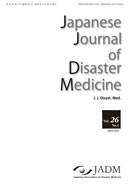Volume 27, Issue 1
Displaying 1-17 of 17 articles from this issue
- |<
- <
- 1
- >
- >|
Review article
-
2022Volume 27Issue 1 Pages 96-101
Published: April 15, 2022
Released on J-STAGE: April 15, 2022
Download PDF (1685K)
Original article
-
 2022Volume 27Issue 1 Pages 26-34
2022Volume 27Issue 1 Pages 26-34
Published: January 28, 2022
Released on J-STAGE: January 28, 2022
Download PDF (443K) -
2022Volume 27Issue 1 Pages 42-47
Published: January 28, 2022
Released on J-STAGE: January 28, 2022
Download PDF (318K)
Research report
-
2022Volume 27Issue 1 Pages 4-12
Published: January 13, 2022
Released on J-STAGE: January 14, 2022
Download PDF (665K) -
2022Volume 27Issue 1 Pages 13-17
Published: January 13, 2022
Released on J-STAGE: January 14, 2022
Download PDF (336K) -
2022Volume 27Issue 1 Pages 35-41
Published: January 28, 2022
Released on J-STAGE: January 28, 2022
Download PDF (4265K) -
2022Volume 27Issue 1 Pages 55-64
Published: March 25, 2022
Released on J-STAGE: March 25, 2022
Download PDF (528K) -
2022Volume 27Issue 1 Pages 65-74
Published: March 25, 2022
Released on J-STAGE: March 25, 2022
Download PDF (781K) -
2022Volume 27Issue 1 Pages 80-88
Published: April 13, 2022
Released on J-STAGE: April 13, 2022
Download PDF (473K) -
2022Volume 27Issue 1 Pages 110-116
Published: April 15, 2022
Released on J-STAGE: April 15, 2022
Download PDF (419K)
Case report
-
2022Volume 27Issue 1 Pages 18-25
Published: January 28, 2022
Released on J-STAGE: January 28, 2022
Download PDF (3937K) -
2022Volume 27Issue 1 Pages 48-54
Published: February 04, 2022
Released on J-STAGE: February 04, 2022
Download PDF (378K) -
2022Volume 27Issue 1 Pages 102-109
Published: April 13, 2022
Released on J-STAGE: April 13, 2022
Download PDF (263K) -
2022Volume 27Issue 1 Pages 89-95
Published: April 15, 2022
Released on J-STAGE: April 15, 2022
Download PDF (1550K) -
2022Volume 27Issue 1 Pages 117-120
Published: April 22, 2022
Released on J-STAGE: April 22, 2022
Download PDF (339K)
Experience report
-
2022Volume 27Issue 1 Pages 75-79
Published: April 04, 2022
Released on J-STAGE: April 04, 2022
Download PDF (2932K)
Preliminary report
-
2022Volume 27Issue 1 Pages 1-3
Published: January 13, 2022
Released on J-STAGE: January 14, 2022
Download PDF (561K)
- |<
- <
- 1
- >
- >|
